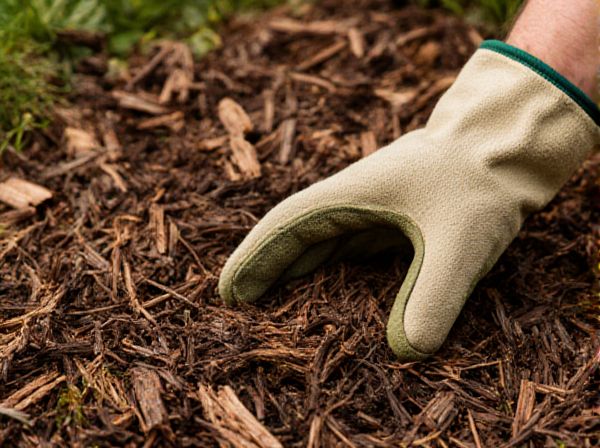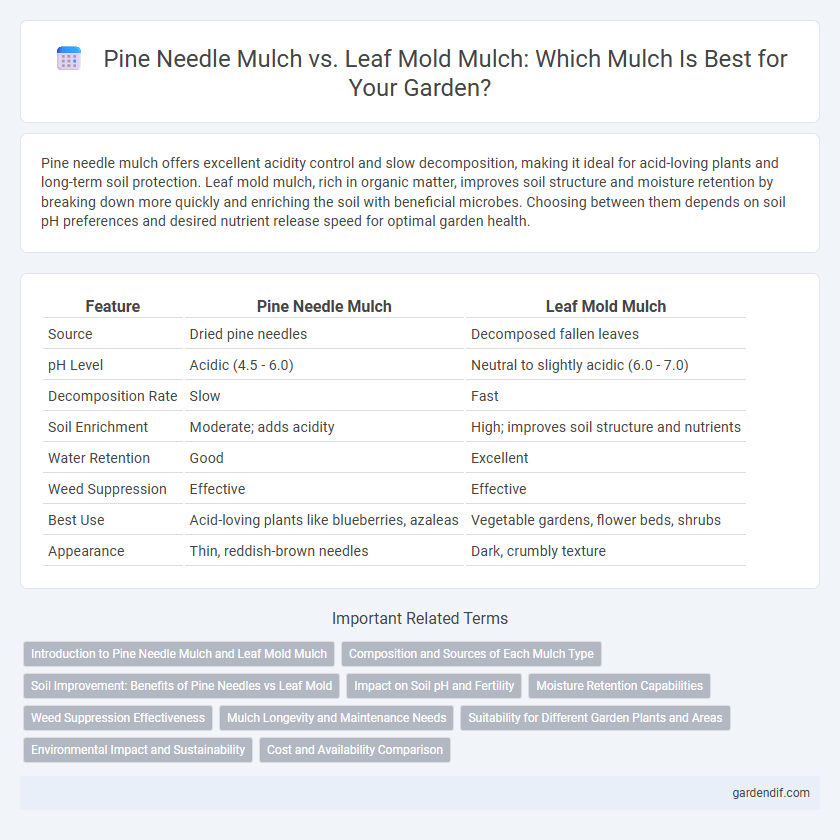
Pine needle mulch vs leaf mold mulch Illustration
Pine needle mulch offers excellent acidity control and slow decomposition, making it ideal for acid-loving plants and long-term soil protection. Leaf mold mulch, rich in organic matter, improves soil structure and moisture retention by breaking down more quickly and enriching the soil with beneficial microbes. Choosing between them depends on soil pH preferences and desired nutrient release speed for optimal garden health.
Table of Comparison
| Feature | Pine Needle Mulch | Leaf Mold Mulch |
|---|---|---|
| Source | Dried pine needles | Decomposed fallen leaves |
| pH Level | Acidic (4.5 - 6.0) | Neutral to slightly acidic (6.0 - 7.0) |
| Decomposition Rate | Slow | Fast |
| Soil Enrichment | Moderate; adds acidity | High; improves soil structure and nutrients |
| Water Retention | Good | Excellent |
| Weed Suppression | Effective | Effective |
| Best Use | Acid-loving plants like blueberries, azaleas | Vegetable gardens, flower beds, shrubs |
| Appearance | Thin, reddish-brown needles | Dark, crumbly texture |
Introduction to Pine Needle Mulch and Leaf Mold Mulch
Pine needle mulch derives from fallen pine needles, offering excellent soil aeration and slow decomposition that enriches acidic soil conditions. Leaf mold mulch, created from decomposed deciduous leaves, enhances soil structure by improving moisture retention and nutrient availability. Both mulches serve unique ecological functions, with pine needle mulch favoring acid-loving plants and leaf mold supporting overall soil fertility.
Composition and Sources of Each Mulch Type
Pine needle mulch consists primarily of decomposed pine needles rich in organic acids and slow-release nutrients, sourced from coniferous forests and pine plantations. Leaf mold mulch is made from decomposed deciduous leaves, high in humus and microbial activity, commonly collected from broadleaf trees in temperate regions. Both mulches improve soil structure but differ in pH impact and nutrient availability due to their distinct compositions and origins.
Soil Improvement: Benefits of Pine Needles vs Leaf Mold
Pine needle mulch acidifies the soil gradually, promoting nutrient availability and enhancing soil structure with its slow decomposition, ideal for acid-loving plants. Leaf mold mulch improves soil fertility by increasing organic matter, moisture retention, and beneficial microbial activity due to its rich humus content. Both mulches boost soil aeration and water retention, but pine needles are better suited for acidic soils, while leaf mold provides a balanced nutrient profile for general soil improvement.
Impact on Soil pH and Fertility
Pine needle mulch tends to acidify the soil over time, lowering the pH and making it ideal for acid-loving plants such as azaleas and blueberries. Leaf mold mulch gradually improves soil fertility by enhancing organic matter content and promoting beneficial microbial activity without significantly altering soil pH. Both mulches contribute to soil structure, but pine needles specifically influence soil acidity, while leaf mold primarily boosts nutrient availability and moisture retention.
Moisture Retention Capabilities
Pine needle mulch provides excellent moisture retention due to its coarse texture and ability to create air pockets that reduce evaporation. Leaf mold mulch, rich in decomposed organic matter, holds moisture effectively by absorbing and slowly releasing water into the soil. Both mulches improve soil hydration, but leaf mold excels in long-term moisture conservation, while pine needles offer a balance of moisture retention and aeration.
Weed Suppression Effectiveness
Pine needle mulch provides excellent weed suppression due to its dense mat-like structure that blocks sunlight, preventing weed seed germination more effectively than leaf mold mulch. Leaf mold mulch decomposes faster, allowing some weed seeds to take root before the mulch breaks down sufficiently. Using pine needle mulch can reduce the need for frequent weeding by maintaining a consistent barrier against weed growth.
Mulch Longevity and Maintenance Needs
Pine needle mulch offers excellent longevity due to its slow decomposition rate, making it a low-maintenance option that requires less frequent replenishment compared to leaf mold mulch. Leaf mold mulch breaks down faster, enriching soil with organic matter but demanding more regular replacement to maintain effective coverage. The choice between these mulches depends on balancing long-term durability with soil enhancement and upkeep frequency.
Suitability for Different Garden Plants and Areas
Pine needle mulch offers excellent acidity, making it highly suitable for acid-loving plants such as azaleas, blueberries, and rhododendrons, while also providing good aeration and moisture retention around shrubs and conifers. Leaf mold mulch, rich in organic matter and nutrients, enhances soil fertility and structure, benefiting vegetable gardens, flower beds, and areas requiring improved microbial activity. Selecting between pine needle and leaf mold mulch depends on garden soil pH requirements, plant species preferences, and the desired enhancement of soil ecosystems.
Environmental Impact and Sustainability
Pine needle mulch decomposes slowly, reducing the need for frequent replacement and minimizing waste, while its acidic nature helps improve soil health for acid-loving plants. Leaf mold mulch enhances soil structure and moisture retention by breaking down into rich, organic matter that supports microbial activity and reduces landfill contributions. Both mulches promote sustainable gardening by recycling natural materials and improving soil ecosystems, but leaf mold mulch typically offers a faster nutrient return and better composting benefits.
Cost and Availability Comparison
Pine needle mulch generally costs less and is more readily available in coniferous regions, as it is a byproduct of pine tree pruning and shedding. Leaf mold mulch, while often slightly more expensive due to the longer decomposition process required, is abundant in deciduous forest areas and can be collected seasonally from fallen leaves. Availability fluctuations for leaf mold mulch depend on seasonal leaf drop, whereas pine needle mulch remains more consistent year-round.
Pine needle mulch vs leaf mold mulch Infographic

 gardendif.com
gardendif.com